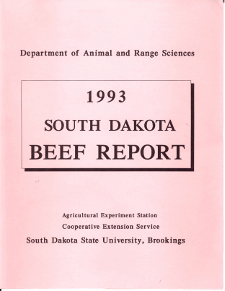Document Type
Report
Report Number
93-15
Publication Date
1993
Keywords
calf, receiving, monensin, coccidiosis
Summary
Monensin was fed in the receiving diets of recently weaned calves at a rate of 0, 10, 20, or 30 g per ton (air dry basis) or 100 or 200 mg per head daily to determine effects on feed intake and coccidia control. The 240 steer calves used originated from western rangelands and had no previous exposure to milled feeds or confinement. During the first week in the feedlot, monensin fed at 30 g per ton depressed feed intake by 5% and the depression response was linear (P<.001) over the range of dosages tested. This reduction in feed intake did not affect average daily gain or calf health. Over 90% of these calves were shedding coccidia oocysts on the first day in the feedlot. Monensin began to suppress (P<.01) oocyst shedding after 10 days on feed and this effect persisted throughout the 84-day experiment. The percentage of calves within a treatment that were not shedding oocysts improved as monensin dosage was increased. These data indicate that intake sensitivity to monensin is primarily related to daily intake of the drug rather than drug concentration in the diet. Furthermore, monensin can be included in receiving calf diets at sufficiently high levels to reduce coccidia oocyst shedding without depressing performance.
Number of Pages
7
Format
application/pdf
Language
en
Publisher
South Dakota State University
Rights
Copyright © 1993 South Dakota State University.
Recommended Citation
Pritchard, R. H. and Thomson, J. U., "Optimum Monensin Levels in Feeder Calf Receiving Diets" (1993). South Dakota Beef Report, 1993. 16.
https://openprairie.sdstate.edu/sd_beefreport_1993/16

